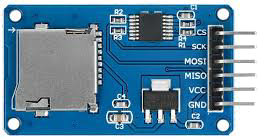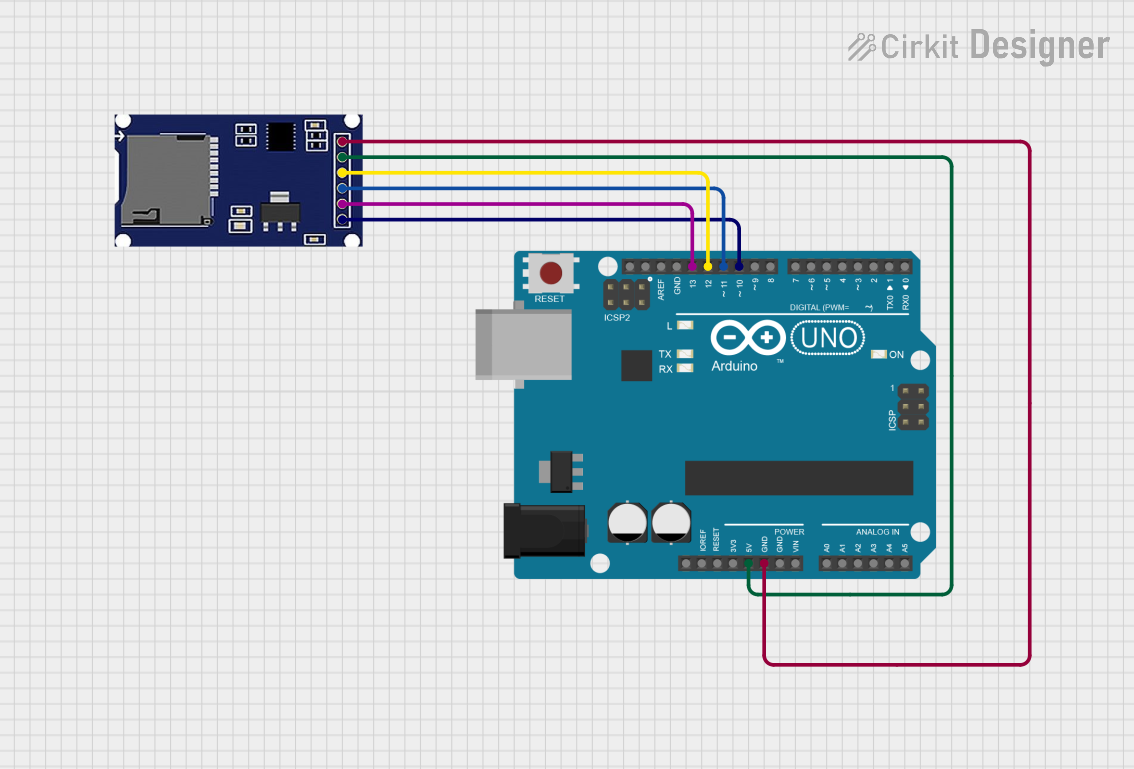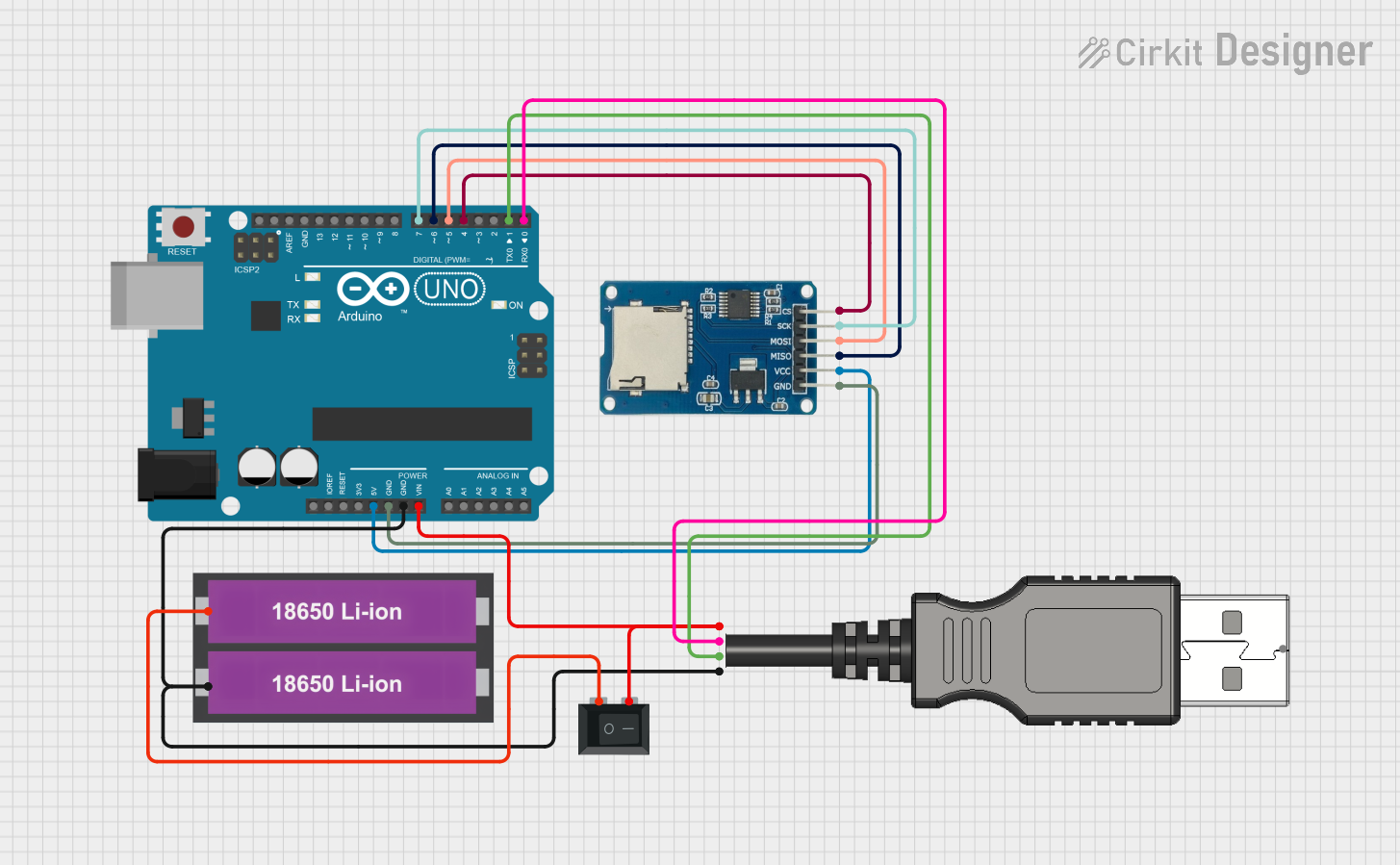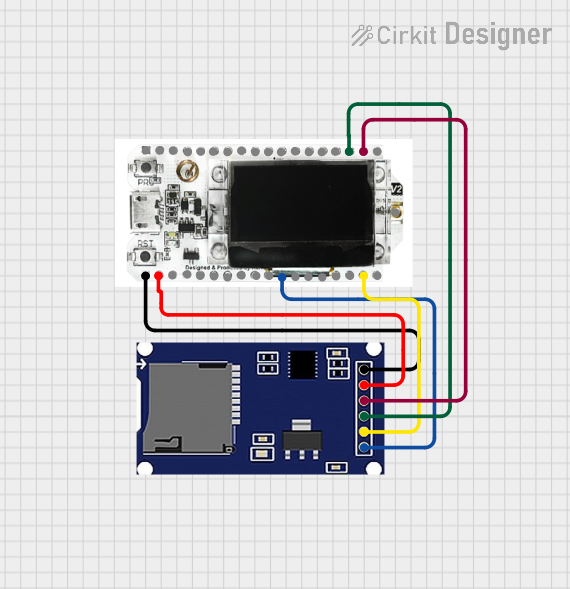
How to Use SD Card Module: Examples, Pinouts, and Specs

 Design with SD Card Module in Cirkit Designer
Design with SD Card Module in Cirkit DesignerIntroduction
The SD Card Module is a compact and versatile component designed to interface SD cards with microcontrollers. It enables the storage and retrieval of data, making it an essential tool for projects requiring large amounts of non-volatile memory. This module is widely used in applications such as data logging, file storage, multimedia playback, and firmware updates.
Common applications and use cases:
- Data logging for sensors in IoT projects
- Storing configuration files or firmware updates
- Multimedia storage for audio, video, or images
- File-based communication between microcontrollers and external systems
Explore Projects Built with SD Card Module

 Open Project in Cirkit Designer
Open Project in Cirkit Designer
 Open Project in Cirkit Designer
Open Project in Cirkit Designer
 Open Project in Cirkit Designer
Open Project in Cirkit Designer
 Open Project in Cirkit Designer
Open Project in Cirkit DesignerExplore Projects Built with SD Card Module

 Open Project in Cirkit Designer
Open Project in Cirkit Designer
 Open Project in Cirkit Designer
Open Project in Cirkit Designer
 Open Project in Cirkit Designer
Open Project in Cirkit Designer
 Open Project in Cirkit Designer
Open Project in Cirkit DesignerTechnical Specifications
- Operating Voltage: 3.3V (logic level) with onboard voltage regulator for 5V input
- Current Consumption: ~100mA (varies with SD card type and operation)
- Supported SD Card Types: Standard SD and microSD cards (FAT16/FAT32 file systems)
- Communication Protocol: SPI (Serial Peripheral Interface)
- Dimensions: Typically 42mm x 24mm x 12mm (varies by manufacturer)
Pin Configuration and Descriptions
The SD Card Module typically has 6 pins. Below is the pinout and description:
| Pin | Name | Description |
|---|---|---|
| 1 | GND | Ground connection |
| 2 | VCC | Power supply input (3.3V or 5V, depending on the module) |
| 3 | MISO | Master In Slave Out - SPI data output from the SD card to the microcontroller |
| 4 | MOSI | Master Out Slave In - SPI data input from the microcontroller to the SD card |
| 5 | SCK | Serial Clock - SPI clock signal |
| 6 | CS | Chip Select - Used to select the SD card module during SPI communication |
Usage Instructions
How to Use the SD Card Module in a Circuit
- Power the Module: Connect the
VCCpin to a 5V or 3.3V power source (depending on the module) and theGNDpin to ground. - Connect SPI Pins:
- Connect the
MISO,MOSI,SCK, andCSpins to the corresponding SPI pins on your microcontroller. - For Arduino UNO, the SPI pins are:
MISO: Pin 12MOSI: Pin 11SCK: Pin 13CS: Any digital pin (commonly Pin 10)
- Connect the
- Insert an SD Card: Ensure the SD card is formatted to FAT16 or FAT32 before inserting it into the module.
- Load the Required Library: Use the
SDlibrary (pre-installed in the Arduino IDE) to interface with the SD card.
Example Code for Arduino UNO
#include <SPI.h>
#include <SD.h>
// Define the Chip Select (CS) pin for the SD card module
const int chipSelect = 10;
void setup() {
// Initialize serial communication for debugging
Serial.begin(9600);
while (!Serial) {
; // Wait for the serial port to connect (for native USB boards)
}
Serial.println("Initializing SD card...");
// Check if the SD card is present and can be initialized
if (!SD.begin(chipSelect)) {
Serial.println("Card failed, or not present");
// Don't proceed if the SD card initialization fails
while (1);
}
Serial.println("Card initialized successfully!");
// Create or open a file on the SD card
File dataFile = SD.open("example.txt", FILE_WRITE);
// Check if the file opened successfully
if (dataFile) {
dataFile.println("Hello, SD card!"); // Write data to the file
dataFile.close(); // Close the file
Serial.println("Data written to file.");
} else {
Serial.println("Error opening file.");
}
}
void loop() {
// Nothing to do here
}
Important Considerations and Best Practices
- Voltage Levels: Ensure the module is compatible with your microcontroller's logic level (3.3V or 5V). Most modules have onboard regulators and level shifters.
- SD Card Formatting: Always format the SD card to FAT16 or FAT32 before use. Unformatted or unsupported file systems may cause initialization errors.
- Chip Select Pin: Avoid conflicts by ensuring the
CSpin is unique if multiple SPI devices are connected. - Data Integrity: Always close files after writing to ensure data is saved properly.
Troubleshooting and FAQs
Common Issues and Solutions
SD Card Initialization Fails:
- Ensure the SD card is properly inserted and formatted to FAT16 or FAT32.
- Verify the
CSpin is correctly defined in the code and connected to the correct pin on the microcontroller. - Check the power supply voltage and current requirements.
File Not Opening or Writing:
- Confirm the file name follows the 8.3 filename convention (e.g.,
example.txt). - Ensure the SD card is not write-protected or full.
- Confirm the file name follows the 8.3 filename convention (e.g.,
Corrupted Data or Files:
- Avoid removing the SD card while the module is powered.
- Always close files after writing to prevent data corruption.
Module Not Detected:
- Double-check all connections, especially the SPI pins.
- Verify the module's power supply and ground connections.
FAQs
Q: Can I use a microSD card with an adapter?
A: Yes, microSD cards with standard SD adapters are fully compatible with the module.
Q: What is the maximum SD card size supported?
A: Most modules support up to 32GB SD cards formatted to FAT32. Larger cards may require additional libraries or configurations.
Q: Can I use multiple SD card modules in one project?
A: Yes, but each module must have a unique CS pin to avoid SPI conflicts.
Q: Is the SD card module compatible with 3.3V microcontrollers like ESP32?
A: Yes, the module is compatible with 3.3V logic levels. Ensure the power supply matches the module's requirements.
By following this documentation, you can effectively integrate the SD Card Module into your projects for reliable data storage and retrieval.